Attitudes: trio of ads shift thinking for good
Author: CIM COM
Tackling knife crime, gender pay inequality and medical errors requires a shift in attitudes and behaviour. These three ads use real life stories, childish naivety and leadership by example to prompt change. Take a look at this creative work from the UK’s Home Office, Norway’s finance union Finansforbundet and the PatientSafe Network with Australian medical teams.
Young people encouraged to go #knifefree
After several years of steady decline, knife crime in England and Wales has risen sharply from around 25,000 incidents in 2014 to over 37,000 in 2017 according to Home Office figures. With injuries and fatalities frequently reported in the media almost daily, the situation has been described as a crisis. Against this backdrop the Home Office has set about changing attitudes amongst 10 to 21-year-olds with its #knifefree campaign.
Knives are often carried for protection, but the reality is that people who carry knives are more likely to end up in hospital with an injury sustained in violent circumstances. Created by FCB Inferno, the campaign is based around true life stories of young people who have been impacted by knife crime and choose to life “knife-free”.
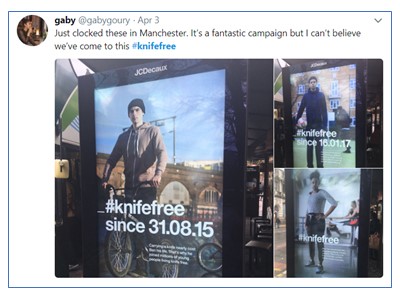 With a £1.3 million campaign budget, the ads target young people via social and digital TV channels, with posters in cities with the worse knife crime.
With a £1.3 million campaign budget, the ads target young people via social and digital TV channels, with posters in cities with the worse knife crime.
The campaign website www.knifefree.co.uk sets out to challenge the misconceptions about carrying knives. It features the true-life stories, and counters current attitudes with its ‘know the risk’ facts, as well as explaining what support is available to go knife-free from charities: Victim support, Childline and Fearless. The website also offers support to parents worried about a young person providing links to Crimestoppers and the NSPCC.
To protect those viewing the website it has a ‘Quickclose’ button which is prominent on every screen. Should someone want their interest in going knife-free to be kept private, for example as someone approaches, they simply have to click the Quickclose button. Although this doesn’t clear the browser history and hitting the back button brings the campaign site back up.
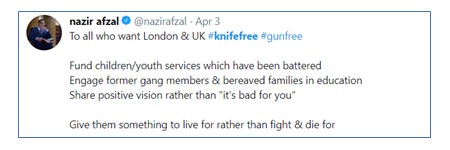 The campaign has difficult ground to cover since no young person likes to be told what to do, and the daily reality of those that carry knives can be extremely tough.
The campaign has difficult ground to cover since no young person likes to be told what to do, and the daily reality of those that carry knives can be extremely tough.
Alongside positive views that it’s a “fantastic campaign”, negative reaction has to be expected and has ranged from the derisory - how do I butter my sandwich? - to those seeing it as an infringement of their freedoms or wanting more far-reaching political change so that the root causes of knife crime are tackled.
Despite criticism the campaign is clearly making progress because it’s getting a reaction. The approach does provide authenticity with its true personal stories and the language it uses such as ‘go knife-free’ is the language of change. It’s treading a sensible line, let’s hope it shifts behaviour to fewer knives carried and fewer knife crimes.
Norwegian kids react to pay inequality
Full-time working women are paid 14% less than men on average according to the OECD. In Norway, the union for the finance workers Finansforbundet explains the issue of equal pay by getting children’s reactions to being paid different rates simply because they are a boy or girl. It makes the point that unequal pay is unacceptable to children so why should we accept this as adults.
Despite the legal requirement to provide equal pay for equal work regardless of gender, women’s experience of pay rates is far from equal due to a multitude of factors, such as men holding more of the top jobs in an organisation. “The gender pay gap for full-time workers is entirely in favour of men for all occupations,” states The Office for National Statistics in the UK “however, occupational crowding has an effect since those occupations with the smallest gender pay gap have almost equal employment shares between men and women. When looking at age groups, the gap for full-time workers remains small at younger ages; however, from age 40 onwards the gap widens reaching its peak between ages 50 to 59.”
The UK government introduced compulsory reporting for companies with over 250 staff on the pay gap between the median hourly rate paid to men and to women full-time employees.
The Fawcett Society, the UK’s leading charity campaigning for gender equality and women’s rights regards gender pay gap reporting as a ‘game changer’. Chief Executive, SamSmethers says:
“It forces employers to look at themselves and understand their organisations and it prompts employees to ask some hard questions. But even better than that, finally women are realising that they have a right to talk about pay and they cannot be silenced. By finding out what their colleagues earn they are then in a position to challenge any pay inequality. It is much more common than people realise.”
Finansforbundet’s video shows its campaigning stance to the newest generation of finance workers and set out the case for equal pay. The children’s unscripted responses said it all:
“She was just as good as me, so we should get the same reward.”
“That is so unfair.”
“That is just weird.”
The video was created by agency Morgenstern and timed to be released on International Women’s Day for maximum impact. The video started on Finansforbundet’s Facebook page and has gone viral. It’s gained traction with over 600,000 Facebook views and 170,000 views of the version with English-subtitles. In the finance sector in Norway, women earn 20% less on average than men so despite Norway been recognised as a progressive country there is clearly a change required and the message is relevant and timely. The ‘child’s play’ approach is an effective brand vehicle for the finance union Finansforbundet since it clearly shows its mission to promote employee rights.
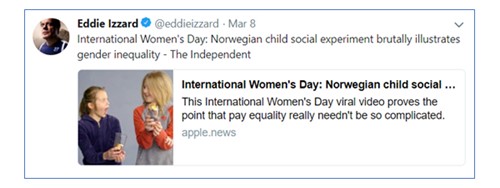
Despite widespread sharing of the video, some have questioned whether it really does demonstrate the injustice of unequal pay. But without tighter laws, campaigning is the next best route. It may be some time until any other countries follow Iceland’s example, making gender pay inequality illegal. In January 2018 it passed a new law requiring companies with more than 25 staff to obtain government certification of their equal pay policies – or face fines and auditing. See the Huffington post report
Aussie medics start #TheatreCapChallenge
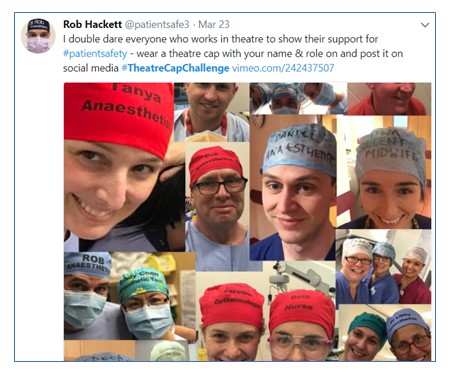
At a time when the Care Quality Commission is reporting back on standards in private hospitals, and highlighting shortfalls, a grassroots movement is looking to make improvements to hospital performance. After heart disease and strokes, medical error is the third biggest cause of death according to the British Medical Journal. But this isn’t usually due to any lack of medical expertise. The World Health Organisation attributes miscommunication as a major factor when things go wrong in hospitals. Since hospital professionals work alongside hundreds of different colleagues, often in several different places, not knowing who’s in the team can add to difficulties. Writing the Wrongs, which morphed into #TheatreCapChallenge, aims to overcome this issue in one easy step.
Medical professionals are encouraged to write their name and job role on their theatre caps. The move is the brainchild of the PatientSafe Network and has been put together by Host/Havas in Sydney. But every new movement needs a champion. In this case anaesthetist Dr Robert Hackett led the way in Sydney.
While in the UK midwife Alison Brindle took up the challenge and spread the word by sharing an enlightening lesson in leaderships courtesy of a dancing man at a festival.
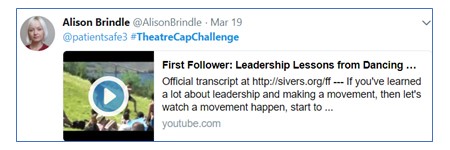
See the Youtube video: First follower leadership lessons from dancing guy.
The PatientSafe Network website lays out more detail on the initiative and interestingly on the barriers to changing behaviour.
See: TheatreCapChallenge where’s the evidence
The review makes the point that change happens best where there is support from the organisation itself and its most senior people, rather than relying on individual champions to drive change. But sometimes change has to start outside the normal lines of authority, since those structures accepted the previous status quo. This campaign has to be applauded for its simplicity and effectiveness.
Introduction to digital marketing for medical marketers
For those working in the medical marketing sector there’s a CIM introductory workshop for medical marketers, product managers and sales people who would like to understand how digital marketing can help them communicate with their customers. Learn how to build an integrated programme using digital tools that are familiar to consumer marketers but often poorly adopted in the medical industry, giving you competitive advantage at little financial cost.
